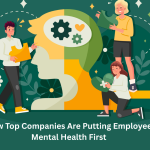Introduction
In 2025, workplace conversations are expected to focus more on employee mental health than just productivity and deadlines. Employees are speaking out about stress, anxiety, and burnout, prompting organizations to take meaningful steps to support well-being. Companies now recognize that a healthy workforce is both an ethical responsibility and a smart business strategy. Prioritizing mental health leads to higher engagement, lower attrition, improved productivity, stronger teamwork, and a positive workplace culture. Businesses are implementing measures such as counseling services, flexible schedules, wellness programs, and mental health training, creating an environment where employees can manage stress and perform at their best.
Why Mental Health Is Now a Workplace Priority
Several factors have made mental health a central topic in workplaces. Stress from hybrid and always-on work, coupled with global events like pandemics and economic uncertainty, has increased burnout, anxiety, and fatigue. Employees now expect active support, including trained managers and resources to address mental health, as lack of support can lead to disengagement and turnover. Poor mental health also costs businesses billions annually through absenteeism, reduced productivity, and higher healthcare expenses. In response, companies are implementing counseling services, flexible schedules, wellness programs, and fostering open cultures to support employee well-being.
Policies That Put People Before Profit
Progressive organizations recognize that the well-being of employees is essential for sustained success. Examples of successful policies include:
- Flexible working hours that honor personal life.
- Compulsory mental health days distinct from vacation days.
- Well-defined limits regarding communication after hours.
By implementing policies that prioritize individuals, organizations foster a culture where employees feel appreciated. This, consequently, enhances loyalty and promotes engagement, demonstrating that profitability and people can coexist harmoniously.
Wellness Programs That Actually Work
xpanded wellness programs: Many organizations are now investing in comprehensive wellness initiatives that go beyond basic perks like gym memberships or meditation apps, recognizing that employee well-being requires multi-faceted support.
Counseling services: Professional counseling is offered to help employees manage both personal and work-related challenges, including stress, anxiety, family issues, or workplace conflicts.
Peer support networks: Programs connect employees with colleagues to provide mutual support, reduce feelings of isolation, encourage sharing of experiences, and build a sense of community within the workplace.
Workshops and training: Organizations conduct workshops and training sessions on stress management, resilience-building, mindfulness, and emotional intelligence, equipping employees with practical skills to cope with workplace pressures.
Holistic integration into company culture: Successful wellness programs are embedded into the company’s culture rather than being isolated initiatives. When well-integrated, they help normalize conversations around mental health, reduce stigma, boost employee engagement, lower stress levels, and improve overall productivity.

How Leaders Are Changing the Conversation
A key factor in determining workplace culture is leadership. Teams are influenced by managers who are candid about mental health. This entails:
- Promoting frequent check-ins to assess worker stress.
- To lessen stigma, people share their personal tales.
- realizing that performance measures are just as vital as mental health.
Employees are more likely to ask for assistance and make use of the tools provided when leaders normalize these discussions, fostering a supportive culture as opposed to one of silence.
The Role of Technology in Employee Well-Being
Technology has profoundly changed the manner in which companies address mental health within the workplace.
Organizations are now utilizing mental health applications that provide mindfulness activities and stress-monitoring tools, along with virtual therapy platforms that facilitate counseling access from any location.
Employee feedback mechanisms can track signs of burnout in real-time, assisting employers in recognizing problems before they worsen.
Although technology cannot substitute for human empathy, it offers scalable solutions that empower organizations to take proactive measures in supporting employee well-being and fostering a healthier, more supportive work atmosphere.
Success Stories From Global Companies
Several international corporations exemplify commendable workplace mental health initiatives:
- Microsoft implemented compulsory “well-being” hours along with flexible work schedules, leading to enhanced employee satisfaction.
- Unilever incorporated mental health workshops into their performance evaluations, which has led to a decrease in burnout.
- Salesforce provides comprehensive counseling and wellness programs, which have boosted productivity and lowered employee turnover.
- These examples illustrate that prioritizing mental health is not merely a passing trend it is a validated approach for achieving long-term organizational success.
What Other Businesses Can Learn
Organizations of all sizes can implement essential insights:
- Start with small initiatives, but maintain a broad vision – even slight adjustments in policy can lead to significant improvements.
- Evaluate outcomes – monitor participation, absentee rates, and employee input to determine the success of programs.
- Educate leaders – supervisors must be prepared to identify stress and direct employees to appropriate resources.
- Encourage conversations – foster an environment where discussing mental health is welcomed rather than shunned.
By following these guidelines, businesses can cultivate workplaces where employees flourish, rather than merely endure under heavy workloads.
Conclusion
Mental health in the workplace is no longer a secondary concern it’s central to employee engagement, productivity, and business success. Policies, wellness programs, leadership initiatives, and technology all help shape healthier workplaces. In 2025, businesses that ignore mental health risk burnout, disengagement, and talent loss, while those that prioritize it set themselves up for sustainable success. Wiraa, a global remote job platform, supports this shift by promoting work-life balance, respecting personal time, and fostering a culture that values mental well-being, showing that employee health is both ethical and strategic.



